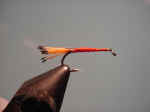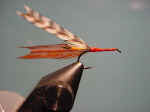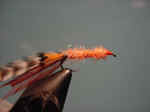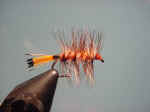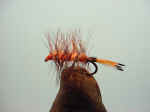|
Fly of the Month Bob Ireton brings together his experience in fly fishing, aquatic entomology, and knowledge of fly tying techniques and materials, to design and tie durable and effective flies. |

|
![]()
Volume 2, Issue 10
October 2001
![]()
ORANGE PALMER
By Bob Ireton
Photography by Bob Kimsey and Bob Ireton
The Orange Palmer is an attractor dry fly that is a
regional pattern of the Great Smoky Mountain area. Best fished mid day and
afternoons during September and October. Other color variations of this fly are
appropriate for other times of the year.
I asked Roger Lowe, of Lowe Fly Shop, in Waynesville, North Carolina, and fishing editor of the new 'Southern Anglers Journal', if he would share some background on this fly. He said, "The pattern goes back to the early 1950's. There are several color variations tied for different times of the year. They are basically tied the same, with different colors for the body. The first ones were tied in the Catalochee area, and named for Palmer Creek."
Thanks, Roger, for the information. By the way, Roger just
moved about a block to his new shop. If you are down that way, stop in and see
him!
MATERIALS:
Hook: TMC 100, Dai-Riki 300, Daiichi 1100, Mustad 94840, Orvis 1509 Size 12-16
Thread: Pale Orange 6/0 for size 12 and larger 8/0 for size 14 and smaller
Tail: Golden Pheasant Tippet Fibers
Hackle: Brown and Grizzly dry fly hackle
Body: Orange Polly Dubbing
TYING STEPS:
![]()
Copyright © 1998 - thisyear The Buckeye United Fly Fishers, Inc. Cincinnati, OH 45242
The Buckeye United Fly Fishers, Inc is a non-profit corporation organized under section 501(c)(3) of the Internal Revenue Code, incorporated in the State of Ohio for the preservation, conservation and wise use of our fishing waters and game fish; and to assist in the protection and improvement of our natural resources
